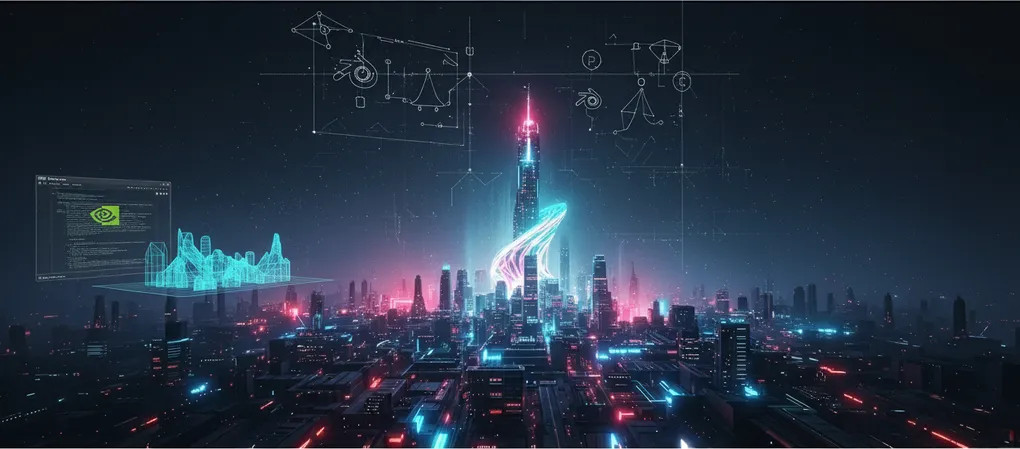
NVIDIA RTX 3D Guided Generative AI: ComfyUI Meets Blender
NVIDIA RTX 3D Guided Generative AI Blueprint Tutorial
NVIDIA has released an innovative open-source project that bridges the gap between 3D modeling and AI image generation. This blueprint allows creators to use simple 3D objects in Blender and guide their design using AI-powered image generation with prompts - all running completely locally.
What Makes This Special
This isn’t just another AI tool. The RTX 3D Guided Generative AI blueprint enables you to:
- Apply any “skin” to 3D environments using simple text prompts
- Automatically fill blank spaces in your 3D scenes with AI-generated content
- Transform basic 3D layouts into stunning, detailed environments
- Run everything locally with no internet connection required after setup
Real-World Examples
The blueprint’s capabilities are best demonstrated through practical examples:
Winter Mountain Village
"A stunning professional photo of a quaint village in the mountains in winter. A snow-covered fountain is visible in the center of the town square."Result: A charming alpine village with a central snow-covered fountain
Hyper-Modern Transformation
The same 3D layout, but with a modern architectural prompt, creates a sleek, contemporary version of the village.
Cartoon Style Rendering
Switch to a cartoon art style prompt and watch the entire scene transform into a stylized, animated version.
Adding Dynamic Elements
Place a simple 3D boat asset in your scene and prompt for “a yacht in the middle of the town on water” - the AI will interpret and render it appropriately within the environment.
System Requirements
Before diving into the installation, ensure your system meets these requirements:
GPU Requirements:
- RTX 5090, 5080, 4090, 4090 laptop, 4080, or RTX 6000
- Note: The team is actively working to support more GPU models
System RAM: 48 GB minimum
Step-by-Step Installation Guide
1. Download NIM Prerequisite Installer
- Visit the NVIDIA AI Blueprints GitHub repository
- Download the NIM prerequisite installer ZIP file
- Run through the installation wizard (AI Workbench will be installed automatically)
2. Install Supporting Software
Git:
winget install --id Git.GitMicrosoft Visual C++ Redistributable:
winget install Microsoft.VCRedist.2015+.x64Blender:
- Download from blender.org or the official GitHub repository
- Run through the standard installation process
3. Set Up HuggingFace Access
- Create a HuggingFace account if you don’t have one
- Navigate to Settings → Access Tokens
- Create a new token with “Read” permissions
- Name it something memorable like “NVIDIA-Comfy”
- Important: Accept the terms of service for all required models listed in the repository
4. Clone and Set Up the Repository
git clone https://github.com/NVIDIA-AI-Blueprints/3d-guided-gen-ai-rtx.git
cd 3d-guided-gen-ai-rtx- Run the
setup.batfile (this will download all necessary models locally) - Keep the terminal window open - you’ll need the ComfyUI and Python paths it displays
5. Configure Blender
- Open Blender
- Go to Edit → Preferences → Add-ons
- Enable the “ComfyUI Blender AI Node” add-on
- Paste the ComfyUI and Python paths from the setup output
- Open the provided
.blendfile from the repository
How to Use the Blueprint
Basic Workflow
- Launch the connection: Click the red “Launch Connect to ComfyUI” button
- Add assets: Drag 3D objects from the asset panel into your scene
- Craft your prompt: Modify the prompt in the 001 panel to describe your desired environment
- Generate: Hit run and watch the AI transform your 3D scene
Prompt Engineering Tips
- Be specific: The AI adheres closely to your prompts
- Context matters: If you add a boat but don’t mention “water” or “boat” specifically, the AI might interpret it differently
- Style variations: Experiment with different art styles (photorealistic, cartoon, modern, vintage, etc.)
Interface Overview
- ComfyUI panel: Located at the bottom of the Blender interface
- Asset browser: Right panel for dragging in 3D objects
- System console: Use Window → Toggle System Console to monitor progress
- Prompt editing: Modify prompts in real-time for immediate feedback
Advanced Techniques
Multi-Angle Generation
Since this works with actual 3D environments, you can:
- Rotate the camera view
- Generate from different angles
- Maintain consistency across viewpoints
Asset Integration
- Start with simple 3D primitives
- Add complex assets from the provided library
- Let the AI interpret and texture everything cohesively
Style Consistency
- Use consistent art direction in your prompts
- Experiment with lighting descriptions
- Try different times of day or weather conditions
Troubleshooting Common Issues
Connection Problems
- Ensure both ComfyUI and Blender paths are correctly configured
- Check that your HuggingFace token is valid and has read permissions
- Verify all models were downloaded successfully during setup
Performance Optimization
- Close unnecessary applications to free up RAM
- Monitor GPU temperature during long generation sessions
- Consider reducing scene complexity for faster iteration
Generation Quality
- Refine your prompts for better results
- Ensure adequate lighting in your 3D scene
- Use reference images in prompts when possible
What’s Next
This blueprint represents just the beginning of what’s possible with 3D AI integration. NVIDIA encourages the community to:
- Fork the repository and build upon it
- Provide feedback on usability and features
- Share creations made with the blueprint
- Contribute improvements back to the open-source project
Conclusion
The NVIDIA RTX 3D Guided Generative AI blueprint opens up exciting possibilities for 3D artists, game developers, and creative professionals. By combining the precision of 3D modeling with the creative power of AI image generation, this tool enables rapid prototyping and visualization of complex environments.
The local, offline nature of the tool makes it perfect for professional workflows where privacy and reliability are paramount. As the technology evolves and supports more GPU models, we can expect even broader adoption and more innovative applications.
Ready to start creating? The repository links and detailed documentation are available in the video description above.
Based on content from: https://www.youtube.com/watch?v=LOaFYFNVpEU